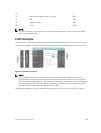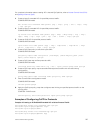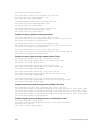
Applications for CAM Profiling
The following describes link aggregation group (LAG) hashing.
LAG Hashing
The Dell Networking OS includes a CAM profile and microcode that treats MPLS packets as non-IP
packets. Normally, switching and LAG hashing is based on source and destination MAC addresses.
Alternatively, you can base LAG hashing for MPLS packets on source and destination IP addresses. This
type of hashing is allowed for MPLS packets with five labels or less.
MPLS packets are treated as follows:
• When MPLS IP packets are received, the system looks up to five labels deep for the IP header.
• When an IP header is present, hashing is based on IP three tuples (source IP address, destination IP
address, and IP protocol).
• If an IP header is not found after the fifth label, hashing is based on the MPLS labels.
• If the packet has more than five MPLS labels, hashing is based on the source and destination MAC
address.
To enable this type of hashing, use the default CAM profile with the microcode lag-hash-mpls.
LAG Hashing Based on Bidirectional Flow
To hash LAG packets such that both directions of a bidirectional flow (for example, VoIP or P2P file
sharing) are mapped to the same output link in the LAG bundle, use the default CAM profile with the
microcode lag-hash-align.
Unified Forwarding Table (UFT) Modes
Unified Forwarding Table (UFT) consolidates the resources of several search tables (Layer 2, Layer 3
Hosts, and Layer 3 Route [Longest Prefix Match — LPM]) into a single flexible resource. Dell Networking
OS supports several UFT modes to extract the forwarding tables, as required. By default, Dell Networking
OS initializes the table sizes to UFT mode 2 profile, since it provides a reasonable shared memory for all
the tables. The other supported UFT modes are scaled-l3–hosts (UFT mode 3) and scaled-l3–routes (UFT
mode 4).
Table 8. UFT Modes —Table Size
UFT Mode L2 MAC Table Size L3 Host Table Size L3 LPM Table Size
Default 160K 144K 16K
Scaled-l3-hosts 96K 208K 16K
Scaled-l3-routes 32K 16K 128K
Configuring UFT Modes
To configure the Unified Forwarding Table (UFT) modes, follow these steps.
1. Select a mode to initialize the maximum scalability size for L2 MAC table or L3 Host table or L3 Route
table.
CONFIGURATION
Content Addressable Memory (CAM)
221


















